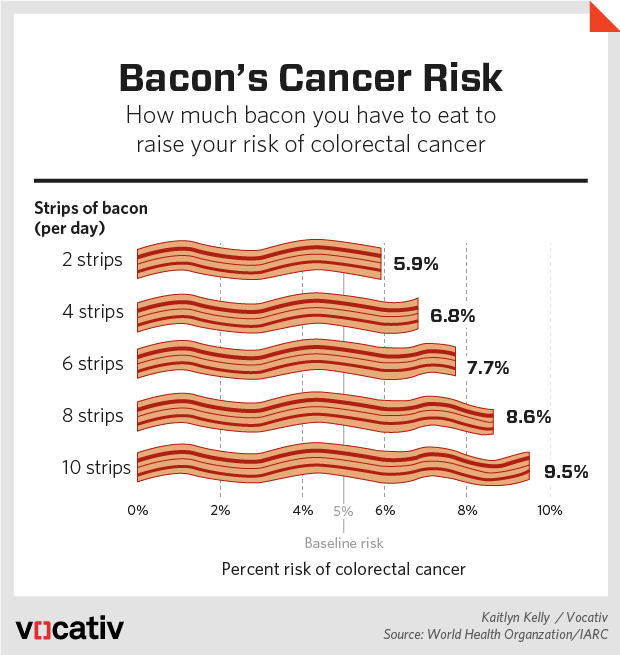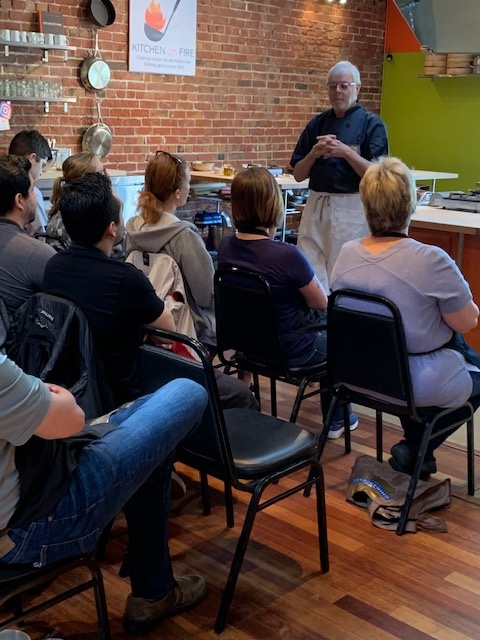
Purina’s Dog Ad: Beggin’ For Bacon
I ran across several articles during my perusal of “food stuff on the web” which sparked an interest in exploring bacon. Of course, thinking about Bacon, and its taste, brings up words like: salty, fatty, tasty, crunchy, and unhealthy. I do not eat bacon much, except for perhaps several times a year when I just cannot stand it anymore. (Sort of like my annual craving for a banana split. If I can wait 20 minutes, the craving goes away.)
To learn about the international politics of bacon I recommend this Guardian article. It gets into ALL the political details. I checked many of their links and they are respectable and trusted sources (some with a definite point of view). So let me start with reviewing the dietary issues related to bacon. These concerns keep me from eating it too often.

Bad News on Bacon
Nitrates + Nitrites
What are nitrates?: Human made or from veggies/fruits, nitrates are used for many purposes, from fertilizer, to explosives, to preserving food. When we speak about nitrates generally, we are really speaking about two types of compounds that are defined by their chemistry.
- Nitrate= 1 Nitrogen, 3 Oxygens – Chemical Formula: NO3- and is a relatively inert chemical until turned into nitrites by bacteria in our mouths or enzymes in our bodies
- Nitrite= 1 Nitrogen, 2 Oxygens – Chemical Formula: NO2- can turn into good Nitric Oxide (which increases blood flow and lowers blood pressure) or bad nitrosamines (can cause DNA damage, cell death and is associated with insulin resistance)
Why use nitrates?: Along with making bacon pinkish, these chemicals maintain bacon’s flavor, prevents off odors, adds a salty flavor, and delays the growth of the bacteria that cause botulism.
Are Nitrates bad?: Our stomachs are high in acid and convert nitrites into nitrosamines, a deadly carcinogen. (By the way, we also naturally produce nitrates, in the form of saliva. Interesting huh?)
Why no concern about natural nitrates in veggies?: When certain compounds specifically found in meat come in contact with nitrates they form cancer causing compounds such as nitrosamine. However, unlike meat, veggies contain vitamin C and other nutrients, as well as naturally occuring nitrates. Vitamin C seems to prevent the conversion of nitrate to nitrosamines. (Does this mean if I ingest orange juice while eating bacon I am safer? Maybe, see below.)
High Saturated Fats + Salt = Unhealthy
Bacon is typically high in sodium and fats (especially saturated fats). Healthline reports that high sodium is a risk factor for high blood pressure. They write: Overconsumption of saturated fat is linked to high cholesterol, which can build up in the arteries and cause heart problems.
One of the issues with bacon is that it is a mouthful of saturated fat that has been designated as a carcinogen. Daily eating, for instance, increases the risk of colorectal cancer by ~18%.
Processed Meat = Unhealthy
ScienceAlert wrote (2015) As of today, the World Health Organisation has officially classified processed meat as “carcinogenic”, alongside such notorious substances as tobacco, arsenic, and pesticides. The Guardian explained that this decision came as a result of advice from 22 cancer experts from 10 countries, who reviewed more than 400 studies on processed meat covering epidemiological data from hundreds of thousands of people.
Despite the science, the Guardian continues, the meat industry was busily insisting that there was nothing to see here. Meanwhile, they report that in January 2019, a new large-scale study using data from 262,195 British women suggested that consuming just 9g of bacon a day – less than a rasher – could significantly raise the risk of developing breast cancer later in life.
Uncured Not Safer
Bacon (and other processed meats) are pinkish because of potassium nitrate (aka saltpetre) and sodium nitrite. The catch here is that a “natural” bacon could be preserved using natural veggies or fruit which are high in nitrates. The label may say “all natural ingredients such as celery salt” but are not required to say celery salts turn into nitrates (2). Bottom line is nitrite is nitrite, no matter what the source.
In efforts to improve bacon, there is a new bacon phrase: “no nitrates or nitrites added.” Cooks write, that bacon labeled this way are usually brined with salt, a bacterial lactic acid starter culture, and celery juice (sometimes listed as “natural flavor”). However, anything that indicates celery juice comes with a caution: Celery juice naturally contains a high level of organic nitrate, which is converted to the problematic nitrite by the bacteria in the starter culture and also by saliva during chewing.
The WaPo verifies that some “uncured bacon” can actually have more nitrates and nitrites than regular bacon. They write: It’s just that, in the “uncured” meats, the nitrite is derived from celery or beets or some other vegetable or fruit naturally high in nitrate, which is easily converted to nitrite. Why could the nitrate be higher? Because celery powder is not regulated. but levels of sodium (or potassium) nitrite are; specifically to no more than 120 ppm.

Good News on Processed Meats
More traditionally processed meat can be safer to consume. These are meats that are preserved with salt or salty brine and lots of time. This older way of preservation is healthier, however, costs more.
- Italy’s Prosciutto di Parma reverted in 2015 to using the older, time tested salting process without any human-made or natural nitrates and nitrites.
- I found a Hickory Smoked non-nitrate bacon at Bentons. They produce a dry cured (by hand) bacon with salt, brown sugar, and black pepper.
Eat bacon with foods containing Vitamin C to offset the creation of the nitrosamine compound. Thus enjoy bacon with tomatoes, potatoes, kale (instead of lettuce), and Avocados.
Eating bacon is probably okay for most people, so long as they eat all processed meats in moderation. That occasional BLT is probably not going to kill you, but having it everyday might increase the odds.

Bacon Nutrition
- Canadian Bacon: Pan Fried: Lower in calories and saturated fat, but this is still considered a processed meat.
- Classic Bacon: Oven Baked: Place bacon slices on an oven-proof rack sitting on a baking sheet that catches the dripping grease. Save the grease in a sealed containers placed in the freezer for when you want a bit of saturated fatty bacon flavor.
- Classic Bacon: Pan-Fried: Of course some numbers are lower when bacon is oven baked and not pan fried.
- “Nitrate Free” Bacon: This is from Oscar Mayer Nautral Smoked Uncured Bacon. Ingredients: PORK, WATER, OF SEA SALT, SUGAR, CULTURED CELERY JUICE, NATURAL CHERRY POWDER. Tastes the same as classic bacon, and is similarly crunchy. However, the addition of the Celery Juice makes this “nitrate free” bacon full of nitrates.
- Prosciutto: The website I am referencing argues that using 2 slices of prosciutto on your sandwich, instead of bacon, will provide some of the flavor yet will be healthier. I am not sure how healthier it is since it has more calories, fat and sodium.
- Turkey Bacon: Jennie-O Turkey: The issue being raised with alt bacon is that it is usually highly processed food which is not good for us either, and does not taste like bacon at all. The most it can provide is a crunch-like texture to a sandwich. I do not like this bacon, I would rather have bacon or just skip this item altogether.
- Meatless Bacon: There is no association between meatless “bacon” and cancer, which is good news. And all the numbers are better than real meat, it also does not taste like meat, or bacon, for that matter.

Best Cooking Technique
Ann Taylor Pittman, posting in TheKitchn, recently wrote an article about which style of cooking bacon she, and her family, preferred. They tested a variety of bacon cooking options and rated (1-10, with 10 best) the results based on: texture, cook time, ease of preparation, cleanup, and appearance. Here is what they found.
- Water based skillet cooking: 5 out of 10
- Microwave: 6 out of 10
- Non-stick skillet frying: 6 out of 10
- Baking on an oven rack in sheet pan: 7 out of 10
- Airfryer: 7 out of 10
- Sous vide: 8 out of 10 (if you have time, 12 hours)
- Cast iron skillet frying: 8 out of 10
- Baking on parchment lined baking sheet: 10 out of 10
Chef + Cook Comments on Bacon
Chef Olive does cook with limited amount of bacon. For instance, he cooked 8 strips once during a 12 week class of 18 students, to use crumbled in their cornbread muffins. This shows his use is moderate and limited, as he does not like to use processed foods. As one of the says at KOF states, “Eat everything. Not every day.”
Cook Jason: I don’t really use bacon in any form in my cooking. I mostly cook vegetarian, so the regular stuff is a no-go, and the fake stuff generally tastes odd and is full of salt. That said, I feel like there is a place for regular bacon along side eggs for a very old-fashioned breakfast, though it’s pretty rare that I eat that, and almost never cook it.
Cook Jen: Bacon is one of those foods that just makes everyone happy. If you are a vegetarian, I feel like bacon is the gateway food. It’s the thing that will convert you over to the meat side. Classic regular bacon is best. It’s good on its own. It’s a great salt/flavor/smokiness enhancer for veggies and salads. It’s great in sandwiches. Grilled cheese with bacon or brussel sprouts with bacon bits are my faves. Salivating just typing about it…
Cook Sasha: Ohhh bacon. It’s one of those foods that almost defaults to being better than whatever else I am comparing it to. Personally, I like thin and crispy normal pork bacon (aka the cheap stuff). I really like the fat that basically becomes cracklins. BLT’s are one of my favorite bacon dishes. I like them with avocado and on focaccia bread with a thick slice of tomato. For breakfast, I also really enjoy the european bacon version. Other types of bacon are decent, but none compare to the original for me 🙂
PattyCooks: Occasionally for my household I will buy and cook a whole package of thickly center cut and uncured bacon (without celery juice). I find it is all eaten (by mainly one person, not me) within 3 days, as it tends to get nibbled on, and suddenly everything requires a bit of it.
–Patty
–**–
NEWS: In a couple of opinion polls, folks indicate they hate 1) cranberry sauce, and 2) green bean casseroles. They report, Additionally, 40% of Millennials said they would rather give up sex for a month than be responsible for cooking Thanksgiving dinner, and 42% of men said they would rather give up football. I however love cranberry sauce and enjoy the cooking.
NEWS: Keep an eye out for the newish Cosmic Crisp apple. It has a long shelf life (in the fridge), and has a dark red skin with white specks. Right now my favorite apples, in order, are: Honeycrisp, Pink Lady, Granny Smith. Gala, and Fuji. Now I have not tasted all the apples out there of course, but I favor crisp, juicy and a bit tart.
Your style is soo unique ompared to other people I’ve read stuff from.
Thanks foor postingg wheen youu hasve the opportunity, Guess I ill ust book mark thjs site.